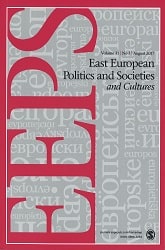Once upon a Time There Was a Big Party: The Social Bases of the Romanian Communist Party (Part I)
Once upon a Time There Was a Big Party: The Social Bases of the Romanian Communist Party (Part I)
Author(s): Cătălin Augustin StoicaSubject(s): Political history, Government/Political systems, Post-War period (1950 - 1989), History of Communism, Sociology of Politics
Published by: SAGE Publications Ltd
Keywords: political sociology; Eastern Europe; social stratification; communist party membership; Romania;
Summary/Abstract: Employing survey data, this article highlights the following characteristics of the Romanian Communist Party (RCP): With an estimated membership of 33 percent of Romania’s employed population, the late RCP was proportionally the largest Leninist party in Eastern Europe. Consistent with the socalled “deproletarianization” thesis, the RCP manifested a marked preference toward recruiting well-educated individuals and professionals among its ranks. The RCP also tended to recruit from among disadvantaged classes (in particular, peasants and their offspring). Despite some prowomen “affirmative action” policies, women were underrepresented among Party members. Some ethnic minorities had fewer chances of joining the RCP than ethnic Romanians. As compared to other communist parties, the RCP had one of the highest rates of intergenerational political reproduction among its ranks. This article suggests that the amorphous character of the RCP and its closed elite could also explain why Party members did not bother to save their historically obsolete leader.
Journal: East European Politics and Societies
- Issue Year: 19/2005
- Issue No: 04
- Page Range: 686-716
- Page Count: 31
- Language: English
- Content File-PDF

